|
Report from
Europe
Another all-time low for UK tropical wood and wood
furniture imports in 2024
In 2024, the UK imported 383,200 tonnes of tropical wood
and wood furniture products with a total value of US$994
million, respectively 3% less and 6% more than the
previous year. In tonnage terms this was the lowest on
record and, in retrospect, may be seen as a continuation of
a long-term downward trend that started as far back as the
2008 financial crisis (Chart 1).
Import quantity last year was around half the level of
tropical wood imports into the UK typical two decades
ago. There was an upturn in UK tropical wood product
imports in 2015-2019, and another rebound in 2020-2022,
but these trends were driven respectively by a big increase
in imports of plywood faced with tropical hardwoods from
China, and then by the short-lived post-COVID boom.
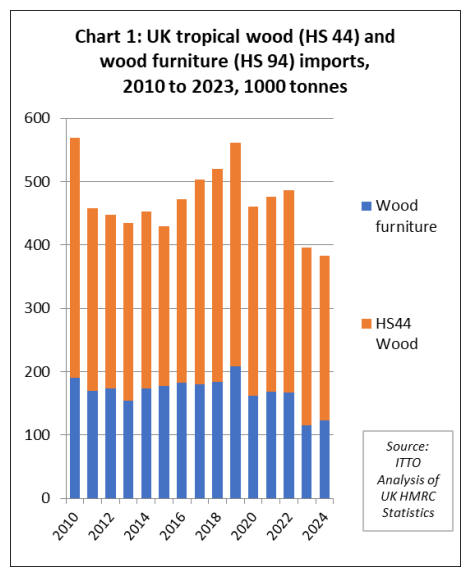
Although UK imports of wood furniture and joinery
products rebounded in 2024 after a very sharp decline in
2023, imports of tropical plywood, sawnwood, and
mouldings continued to slide last year.
UK imports of tropical wood and wood furniture in the
fourth quarter of 2023 were 101,280 tonnes, a reasonable
performance in the context of the wider market slowdown,
this being 14% up on the previous quarter and 15% greater
than the same quarter in 2023. That provides some
encouragement that the market may have hit bottom
already.
Underlying the historically low levels of import in 2024 is
the weakness of the UK economy. According to the Office
of National Statistics, UK gross domestic product (GDP)
is estimated to have grown by 0.9% in 2024, while GDP
per head fell by 0.1%.
Much of the growth last year was concentrated in the first
six months. GDP expanded by just 0.1% in Q4 2024,
following no growth in the previous quarter. In February,
the Bank of England predicted that the UK economy will
grow by just 0.75% in 2025, down from its previous
estimate of 1.5%.
The UK Construction Products Association (CPA) Winter
Forecast issued in January predicts 2.1% growth in the UK
building sector this year. This is a significant improvement
following two challenging years with construction output
falling by 6.8% in 2023 and by another 2.9% in 2024.
The declines particularly affected the two largest sectors –
private housing new build and repair, maintenance and
improvement. However, the CPA’s forecast recovery for
this year is a downward revision compared to 2.5% growth
expected in their Autumn 2024 Forecast. The CPA now
expects slower economic growth this year, higher inflation
for longer, and fewer interest rate cuts than in their
previous forecast.
UK import value of wooden furniture from tropical
countries rebounded in 2024
After a 43% decline in UK imports of wood furniture from
tropical countries in 2023, imports rebounded by 9% to
US$457 million in 2024. In quantity terms, wood furniture
imports were 122,400 tonnes in 2024, 6% more than in
2023.
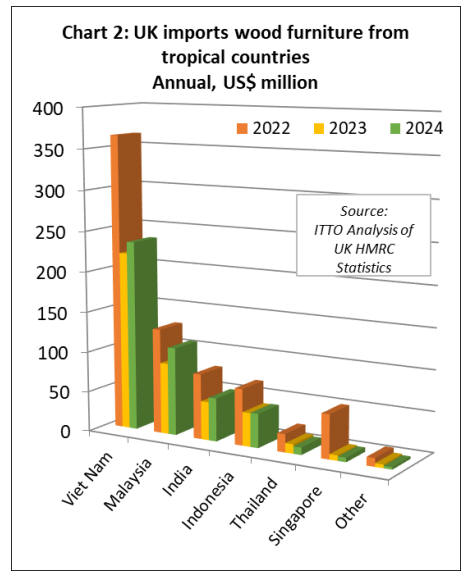
Tropical wood furniture imports in 2024 increased for all
leading supply countries to the UK including Vietnam
(+7% to US$235 million), Malaysia (+23% to US$109
million), India (+13% to US$53 million), and Indonesia
(+1% to US$42 million). However, imports declined from
Thailand (-22% to US$9 million), and Singapore (-18% to
US$5.4 million). UK wood furniture imports were
negligible from all other tropical countries in 2024 (Chart
2).
UK import value of tropical wood joinery increases
11% in 2024
Total UK import value of tropical joinery products
increased 11% to US$218 million in 2024 and import
quantity increased 6% to 74,100 tonnes. The biggest
rebound was in UK imports of tropical wood joinery
products from the EU, up 43% to US$53 million during
the year.
UK import value of joinery products from Indonesia
(mainly doors) was US$104 million in 2024, up 9% on the
previous year but still well short of US$138 achieved in
2022. Imports from Malaysia (mainly laminated products
for kitchen and window applications) fell 10% to US$24
million in 2024, continuing the slide that set in the
previous year.
UK import value of tropical wood joinery products from
China, nearly all doors, was US$24 million in 2024, 6%
more than the previous year. UK import value of joinery
products from Vietnam increased 2% to US$8.1 million
during the year (Chart 3).
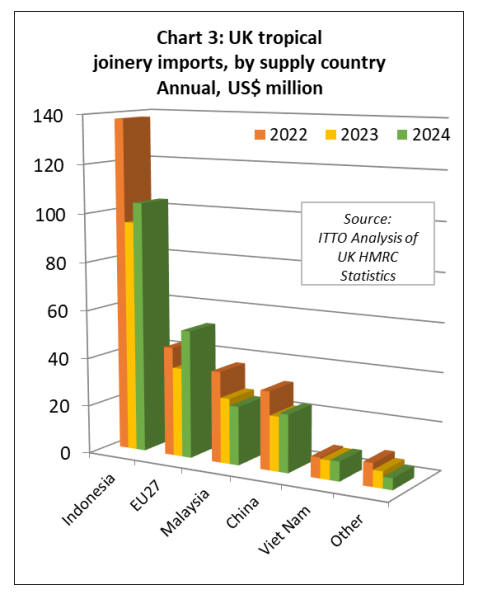
UK imports of tropical hardwood plywood from China
fall sharply
In 2024, the UK imported 178,400 cu.m of tropical
hardwood plywood, 12% less than the previous year.
Import value fell less sharply, by 5% to US$113 million.
The increase in the unit value of tropical plywood imports
into the UK last year was due to a sharp decline in imports
of lower-value plywood with an outer layer of tropical
hardwood from China. Direct imports of higher-value
tropical hardwood plywood from tropical countries were
more stable last year (Chart 4).
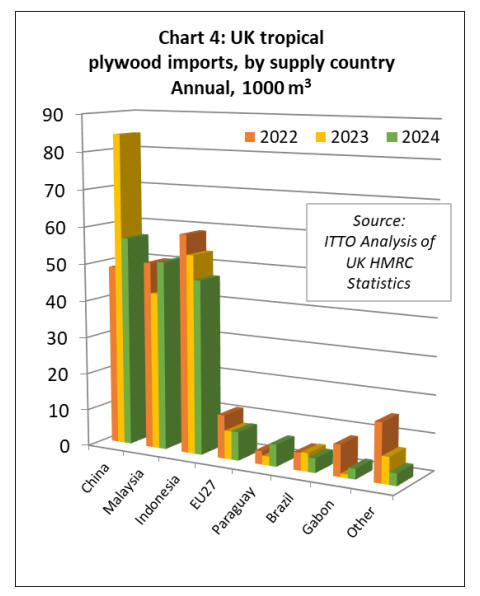
The UK imported 56,700 cu.m of plywood with an outer
layer of tropical hardwood from China in 2024, 34% less
than the previous year. UK imports of tropical hardwood
plywood direct from tropical countries increased 2% to
114,000 cu.m in 2024.
Imports were up 20% to 51,000 cu.m from Malaysia, up
145% to 5,900 cu.m from Paraguay, and up 181% to 2,800
cu.m from Gabon. These gains offset a decline of 12% to
47,100 cu.m from Indonesia and 21% to 3,900 cu.m from
Brazil. UK imports of tropical hardwood plywood from
EU countries were 7,700 cu.m in 2024, 1% more than the
previous year.
Rising share of tropical sawnwood imports into the UK
from the EU
UK imports of tropical sawnwood were 88,380 cu.m in
2024, 9% less than the previous year. Import value fell 4%
to US$107 million during the year. The UK imported
25,900 cu.m of tropical sawnwood from EU countries in
2024, down 1% compared to the previous year but
accounting for a higher share (29% compared to 27%) of
all UK imports of tropical sawnwood during the year
(Chart 5).
The UK’s high dependence on indirect imports of tropical
sawnwood from the EU is partly due to a shortage of kiln
drying space in African supply countries combined with
lack of any hardwood kiln drying capacity in the UK.
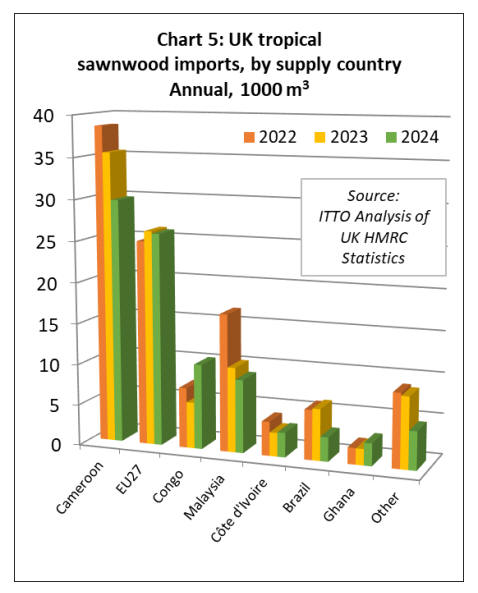
A large share (34% in 2024) of sawnwood sourced directly
from the tropics by UK importers comes from Cameroon,
but the Republic of Congo (RoC) increased share in the
UK market last year.
UK imports of tropical sawnwood from Cameroon were
29,800 cu.m in 2024, 16% less than the previous year,
while imports from RoC increased 84% to 10,370 cu.m.
Imports from Cote d’Ivoire and Ghana also increased in
2024, respectively by 4% to 3000 cu.m and by 40% to
2,750 cu.m. However, imports from Malaysia fell by 14%
to 8,900 cu.m in 2024 and imports from Brazil were down
53% to 2,950 cu.m.

UK imports of tropical hardwood mouldings/decking fell
7% to 9,400 tonnes in 2024. Import value was down 5% to
US$26.6 million.
Although UK imports of this commodity from Malaysia
increased by 22% to 3,100 tonnes in 2024, this was offset
by falling imports from Indonesia (-9% to 2,900 tonnes)
and Vietnam (-36% to 500 tonnes). Imports from EU
countries also fell, by 27% to 1,800 tonnes. Imports from
Brazil were static at 500 tonnes (Chart 6).
China boosted share of UK wood product imports in
2024
The UK market for tropical wood and wood furniture
products last year performed marginally better than the
wider UK market for wood and wood furniture products.
In real terms (accounting for inflation), total UK import
value of these products remained static at US$10.6 billion
in 2024, while the value of tropical product imports
increased by 3%. The share of tropical wood and wood
furniture products in total UK imports increased slightly
from 9.3% to 9.5% last year. However, it was still down
on the 11.4% share achieved in 2022.
Considering longer term trends, the recent development of
the UK market for tropical wood and wood furniture
products is disappointing. Following the UK’s withdrawal
from the EU, an event that occurred five years ago, there
was speculation that higher transaction costs in EU-UK
trade might encourage more purchasing of wood products
from further afield, including in the emerging
manufacturing sectors of tropical countries.
What happened in practice was that UK imports from the
EU, both in absolute terms and in share, confounded
expectations by increasing during the immediate post-
Brexit period. The COVID pandemic was a factor during
this period, the huge increase in shipping costs and
disruption to production in Asia encouraging the UK to
import more from the EU. The war in Ukraine tended to
deepen this trend as supplies from Russia and Ukraine
dried up. During the period 2019 to 2023, the EU’s share
in total UK imports of wood and wood furniture products
increased from 49% to 62% (Chart 7).
In 2024, a new trend emerged as the UK finally began to
import a larger share of wood and wood furniture products
from outside the EU. However, the only real beneficiary of
this trend so far has been China.
China’s share of UK imports increased from 21% to 24%
last year, mainly at the expense of the EU whose share fell
from 62% to 58%. This trend may well continue as
China’s manufacturers seek to increase exports to
countries other than the U.S., in the face of rising tariffs,
and the EU where EUDR is creating new challenges for
Chinese manufacturers.
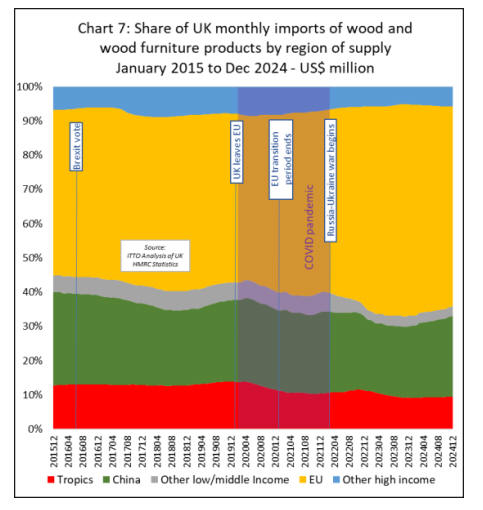
|